Tupolev Tu-22M 'BACKFIRE'
Role: Medium Bomber
Origin: Russia
Design: Tupolev
Production: State Aviation Plant No.22 Kazan
Variants: Tu-22M0 (Backfire-A), Tu-22M1 (Backfire-A), Tu-22M2 (Backfire-B),
Tu-22M3/MR/MP (Backfire-C)
Operators: Russia/USSR, Ukraine
Current Operators: Russia
The Tupolev Tu-22M (NATO 'Backfire') is a supersonic medium bomber which was designed to replace the subsonic Tu-16 and the troublesome Tu-22 missile carriers. Although its designation may suggest that the 'Tu-22M' Backfire is basically a modified Tu-22 'Blinder' it is a completely different and new design with only a few small Tu-22 features maintained. The Tu-22M design features a variable geometry wing which is also found on contemporary tactical fighters and the American B-1B bomber. The two turbofan afterburning engines are unlike almost every other bomber located in its fuselage body, with large shoulder mounted intakes, more similar to contemporary tactical fighters and fighter-bombers.
The aircraft can be equipped with up to three Kh-22 air-to-surface missiles, with one under each wing and a third under its belly, semi-recessed into the bomb bay. The second ASM option is the Kh-15 (NATO AS-16 'Kickback') on a six-round launcher carried in the bomb bay. Up to four external bomb racks can be equipped, each rack capable of carrying nine conventional 250kg general purpose bombs. Also the 500, 1500 and 3000 kg conventional bombs can be equipped. The Tu-22M is equipped with a Leninets PN-A attack radar in the nose and a OPB-15T television sight for optical bomb aiming located below the fuselage just in front of the nose gear.
The Tu-22M has a crew of four: commander (left front), co-pilot (right front), communications officer (left rear) and navigator (right rear). All crew is sitting on KT-1 ejection seats which fire up, a much improvement after the downward firing seats in the Tu-22 Blinder. The rear crew have no forward visibility, but have a large side window each.
The first production variant was the Tu-22M2. The variant was capable of being refuelled in flight. However after the SALT treaty the probe was removed, remaining the probe housing. Later the probe housing was also removed, but the aircraft keeps the bulge-like shape of the nose.
The latest version, the Tu-22M3 or 'Backfire-C', has two NK-25 engines replacing the original NK-22s. The new engines coupled with redesigned engine intakes boosted performance. Also the maximum wing sweep was increased back to 65 degrees. The Tu-22M3 is capable of Mach 1 at low level and has a max speed of Mach 2.05. The Tu-22M3 was also armed with a new weapon, the Raduga Kh-15 which was better suited against enemy air defences than the obsolete Kh-22. Probably because of the large available inventory of Kh-22 missile, the Kh-22 was improved (Kh-22M and Kh-22MA) and remained in service on the Tu-22M.
Although satellites took over the role of the Tu-22R for the larger part, a small number of Tu-22M3s were modified for the reconnaissance role. The designation for this variant is Tu-22M3(R) or Tu-22MR. The variant has a large sensor package (equivalent to that of the Tu-22RDM) built into the bomb bay.
The ECM package of the Tu-22M2 and despite improvements the Tu-22M3 was not considered adequate and an escort jamming aircraft was needed. The old Tu-16P was too slow for the job and two alternatives were considered. One being the Tu-22MP, a Tu-22M3 fitted with the Miass electronic warfare system. Three prototypes were built by 1992 but the type did not enter service. The other option was the Il-76PP, a converted Il-76 transport. It was equipped with the Dandish system which could not be equipped to the Tu-22M3 because it required too much power. One prototype was tested, but none were produced.
No Tu-22M Backfires were exported, although China and Iran showed serious interest in the 1990s. Lately there have been reports that the Tu-22M3 is offered to India for the maritime attack role, probably armed with the conventional anti-ship Kh-15A (export designation Kh-15S) missile. Russia remains the biggest operator of the type, which will probably remain in service for the foreseeable future because a replacement (T-60S program) will prove too expensive. In 1997 a study for the upgrade of the Tu-22M3 was started under the name of project 245 or Tu-245. Ukraine was the only other operator, it inherited a Tu-22M3 regiment after the Soviet Union collapse. Some of these remained in service as 'strategic deterrence' initially, but were retired and reduced to scrap during the latter part of the 1990s and early 2000s.
-
Sources:
- Tupolev Bombers (ISBN 1880588625)
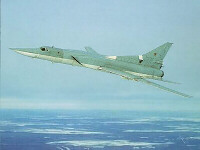
Russian Tu-22M3 'Backfire'
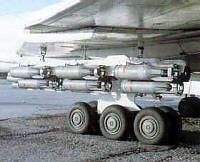
Bomb rack with 250-kg HE bombs
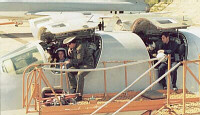
Crew boarding
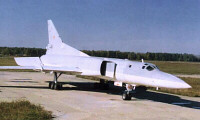
Tu-22M2 first production variant
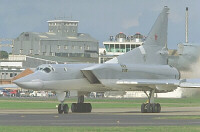
Tu-22M3 new engines and intakes
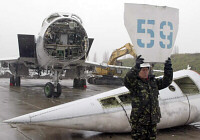
Ukrainian Tu-22M3 being scrapped
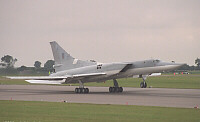
Ukrainian Tu-22M3 taking off

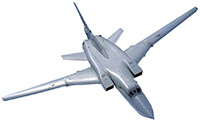
 Back to Index
Back to Index